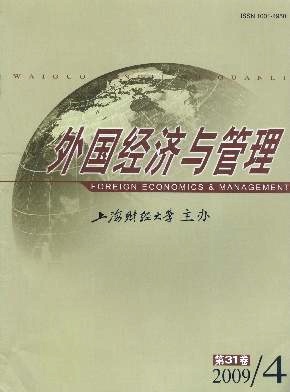全球化环境下的跨学科、跨文化品牌名称研究探析
外国经济与管理 2009 年 第 31 卷第 04 期, 页码:51 - 58
摘要
参考文献
摘要
随着市场全球化的不断深化,东西方学术界越来越重视消费者行为研究领域的跨文化研究。本文紧跟这一国际潮流,着重考察品牌名称跨文化研究的发展脉络和最新发展方向,对与品牌名称研究相关的三个交叉领域做了重点梳理,指出了品牌名称研究的跨学科、跨文化趋势,并对未来研究方向进行了预测。
[1]Kotler,P,and K L Keller.Marketing management[M].(12th Ed.).NewJersey:Pearson International Edition,2006:22.
[2]Keller,K L,S E Heckler,and MJ Houston.The effects of brand name suggestiveness on advertisingrecall[J].Journal of Marketing,1998,62(Jan.):48-57.
[3]Maheswaran,D,D M Mackie,and S Chaiken.Brand name as a heuristic cue:The effects of taski mportance and expectancy confir-mation on consumer judgments[J].Journal of Consumer Psychology,1992,1(4):317-336.
[4]Kotler,P,and G Armstrong.Principles of marketing[M].(10th Ed.).New York:Pearson Education,Inc.,2005.
[5]Keller,K L.Brand synthesis:The multidi mensionality of brand knowledge[J].Journal of Consumer Research,2003,29(4):595-600.
[6]Schmitt,B H,Y Pan,and N T Tavassoli.Language and consumer memory:Thei mpact of linguistic difference between Chinese andEnglish[J].Journal of Consumer Research,1994,21(3):419-431.
[7]Chan,A K K,and Y-Y Huang.Brand namingin China:Alinguistic approach[J].MarketingIntelligence&Planning,1997,15(5):227-34.
[8]Chan,A K K,and Y-Y Huang.Principles for brand naming in China:The case of drinks[J].Marketing Intelligence&Planning,2001,19(5):309-318.
[9]卢泰宏.解读中国营销[M].北京:中国社会科学出版社,2004.
[10]Peterson,R A,and I Ross.Howto name new brands[J].Journal of Advertising,1972,12(6):29-34.
[11]Meyers-Levy,J.Theinfluence of a brand name’s association set size and wordfrequency on brand memory[J].Journal of ConsumerResearch,1989,16(Sep.):197-207.
[12]Keller,K L.Conceptualizing,measuring,and managing customer-based brand equity[J].Journal of Marketing,1993,57(1):1-22.
[13]Cohen,J B,and Basu,K.Alternative models of categorization:Toward a contingent processing framework[J].Journal of Consumer Re-search,1987,13(4):455-472.
[14]Zhang,S,and B HSchmitt.Creating local brands in multilingual international markets[J].Journal of Consumer Research,2001,38(3):313-325.
[15]Lee,Y H,and KS Ang.Brand name suggestiveness:AChineselanguage perspective[J].International Journal of Researchin Mar-keting,2003,20(4):323-335.
[16]Mooij,MD.Consumer behavior and culture:Consequences of global marketing and advertising[M].Thousand Oaks:Sage Publica-tions,Inc.,2004.
[17]Shavitt,S,A Y Lee,and T P Johnson.Cross-cultural consumer psychology[A].in C Haugtvedt,P Herr,and F Kardes(Eds.).Handbook of consumer psychology[C].New York:Taylor&Francis Group,2008.
[18]Hong,Y Y.Adynamic constructivist approach to culture:Moving fromdescribing culture to explaining culture[R].Working Pa-per,University of Illinois,2008.
[2]Keller,K L,S E Heckler,and MJ Houston.The effects of brand name suggestiveness on advertisingrecall[J].Journal of Marketing,1998,62(Jan.):48-57.
[3]Maheswaran,D,D M Mackie,and S Chaiken.Brand name as a heuristic cue:The effects of taski mportance and expectancy confir-mation on consumer judgments[J].Journal of Consumer Psychology,1992,1(4):317-336.
[4]Kotler,P,and G Armstrong.Principles of marketing[M].(10th Ed.).New York:Pearson Education,Inc.,2005.
[5]Keller,K L.Brand synthesis:The multidi mensionality of brand knowledge[J].Journal of Consumer Research,2003,29(4):595-600.
[6]Schmitt,B H,Y Pan,and N T Tavassoli.Language and consumer memory:Thei mpact of linguistic difference between Chinese andEnglish[J].Journal of Consumer Research,1994,21(3):419-431.
[7]Chan,A K K,and Y-Y Huang.Brand namingin China:Alinguistic approach[J].MarketingIntelligence&Planning,1997,15(5):227-34.
[8]Chan,A K K,and Y-Y Huang.Principles for brand naming in China:The case of drinks[J].Marketing Intelligence&Planning,2001,19(5):309-318.
[9]卢泰宏.解读中国营销[M].北京:中国社会科学出版社,2004.
[10]Peterson,R A,and I Ross.Howto name new brands[J].Journal of Advertising,1972,12(6):29-34.
[11]Meyers-Levy,J.Theinfluence of a brand name’s association set size and wordfrequency on brand memory[J].Journal of ConsumerResearch,1989,16(Sep.):197-207.
[12]Keller,K L.Conceptualizing,measuring,and managing customer-based brand equity[J].Journal of Marketing,1993,57(1):1-22.
[13]Cohen,J B,and Basu,K.Alternative models of categorization:Toward a contingent processing framework[J].Journal of Consumer Re-search,1987,13(4):455-472.
[14]Zhang,S,and B HSchmitt.Creating local brands in multilingual international markets[J].Journal of Consumer Research,2001,38(3):313-325.
[15]Lee,Y H,and KS Ang.Brand name suggestiveness:AChineselanguage perspective[J].International Journal of Researchin Mar-keting,2003,20(4):323-335.
[16]Mooij,MD.Consumer behavior and culture:Consequences of global marketing and advertising[M].Thousand Oaks:Sage Publica-tions,Inc.,2004.
[17]Shavitt,S,A Y Lee,and T P Johnson.Cross-cultural consumer psychology[A].in C Haugtvedt,P Herr,and F Kardes(Eds.).Handbook of consumer psychology[C].New York:Taylor&Francis Group,2008.
[18]Hong,Y Y.Adynamic constructivist approach to culture:Moving fromdescribing culture to explaining culture[R].Working Pa-per,University of Illinois,2008.
引用本文
郝佳. 全球化环境下的跨学科、跨文化品牌名称研究探析[J]. 外国经济与管理, 2009, 31(4): 51–58.
导出参考文献,格式为:





 6794
6794  587
587

